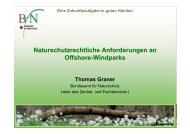You also want an ePaper? Increase the reach of your titles
YUMPU automatically turns print PDFs into web optimized ePapers that Google loves.
<strong>GICON</strong> <strong>Biogas</strong> Process<br />
two-stage dry-wet fermentation with split hydrolysis<br />
High-performance fermenter with effective<br />
utilization of the reactor volume due to the<br />
<strong>GICON</strong> Process.<br />
Filling of a percolator<br />
with agricultural machinery<br />
04<br />
Process flow diagram<br />
of the <strong>GICON</strong> <strong>Biogas</strong> Process<br />
Simple solution - enormous impact<br />
The <strong>GICON</strong> <strong>Biogas</strong> process with most of its major process steps was developed at BTU<br />
Cottbus (Prof. Busch et. al.) in cooperation with <strong>GICON</strong> and has been patent-protected<br />
several times, including internationally (Patent DE 10 2204 053 615.5, additional patent<br />
applications for design details and process variations). It has been designed to operate in<br />
two steps, with a systematic separation of microbiological decomposition steps. During<br />
the first step (hydrolysis), organic components are eluted from the substrate matrix and<br />
converted into organic acids and other water-soluble decomposition products. This<br />
watery solution (hydrolysate), containing organics, is fed into the second step, the methanization,<br />
which is designed as a packed bed vessel. Due to the immobilization of methane-forming<br />
microorganisms on the surface of the packing material, large methaneforming<br />
potentials will be available at any given time. Thus, short residence times of<br />
the hydrolysate can be achieved, a solution which poses a unique option for the controlla-bility<br />
of the biogas production. The environmental conditions (temperature and pH,<br />
among others) are controlled and optimized separately in both process steps. By applying<br />
the innovative <strong>GICON</strong> biogas process, major disadvantages of conventional facilities<br />
are omitted.<br />
Since movement of the solid substrate does not occur during the operation, the system<br />
is robust with respect to possible impurities content. This is especially important for feedstocks<br />
such as biological wastes and landscaping-generated wastes. The use of the<br />
organic fraction of household waste is also possible and has already been successfully<br />
tested. Cleaning and maintenance of the percolation step can occur between substrate<br />
charging cycles without interruption of the biogas generation process.<br />
batch-wise addition and removal of feedstock<br />
multiple percolators<br />
in a garage setup<br />
percolation<br />
percolation<br />
stabile by-product appropriate,<br />
for example, for composting<br />
percolate<br />
= hydrolysate<br />
percolate return<br />
hydrolysate vessel<br />
-buffer storage-<br />
methane<br />
production<br />
control<br />
hydrolysate<br />
methane reactors<br />
return<br />
waste water, liquid fertilizer<br />
biogas<br />
70-80% CH 4<br />
packed bed<br />
aeration and<br />
polishing pool<br />
sludge<br />
liquid<br />
effluent


